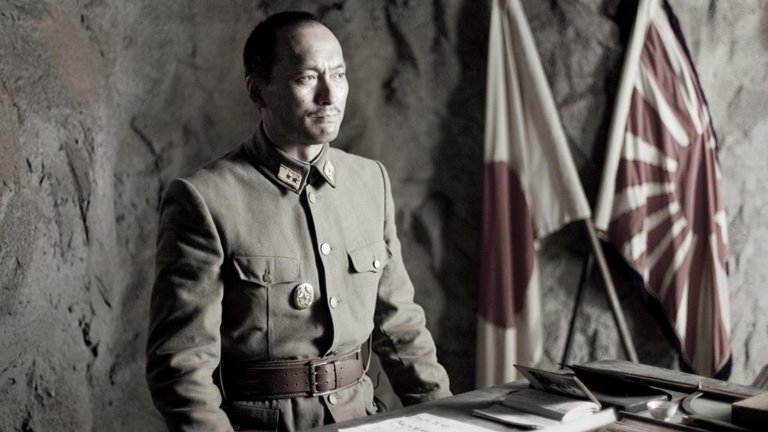Film Review: Letters from Iwo Jima (2006)

The year 2006 was far from ideal for Clint Eastwood to release a film that could be perceived as glorifying the US military, given the ongoing carnage in Iraq. His epic drama Flags of Our Fathers, dedicated to the US Marines' famous and bloody victory in the Battle of Iwo Jima during World War II, faced the risk of being seen as a jingoistic flag-waving spectacle, contradicting the increasing anti-war sentiments within the USA and globally. Despite taking a nuanced approach towards these events, which earned praise from even anti-war critics, Flags of Our Fathers failed to impress at the box office.
Undeterred by this setback, Eastwood ingeniously countered accusations of pro-US bias by filming another movie that depicted the same battle but from the perspective of their Japanese adversaries. This separate film, titled Letters from Iwo Jima, was shot back-to-back with Flags of Our Fathers and released a few months later.
The film begins with a prologue set in 2005, where a team of Japanese archaeologists investigates various artefacts from the battle that occurred sixty years prior. The plot then switches to 1944 when we are introduced to Private First Class Saigo (played by Kaizuo Ninamiya), a baker who was recently conscripted into the Imperial Japanese Army and stationed on the small but strategically important volcanic island of Iwo Jima in the Pacific. The island's significance increased as the war turned against Japan, with US forces potentially using it as an airfield for strategic bombers to attack the Japanese Home Islands.
Lieutenant General Tadamichi Kuribayashi (played by Ken Watanabe), a veteran of pre-war years spent in the USA, arrives to take command of the garrison and organize defenses against the imminent naval invasion. Unlike most Japanese officers, he knows and respects his adversary. That helps him devise new tactics involving extensive use of tunnels and hidden fortifications within the island's interiors to slow down the technically and numerically superior enemy while causing as many casualties as possible. However, Kuribayashi and his men are aware that their defence is doomed from the start, with a weakened Japanese Navy unable to bring reinforcements or supplies.
Despite being directed and produced by Americans, Letters from Iwo Jima looks very much like a Japanese film. Not only are almost all the characters Japanese, but they speak Japanese, which was a rarity for Hollywood films dealing with Japanese in WW2. The filmmakers made great efforts to make the film as authentic as possible.
What is even more important is the nuanced approach towards portraying the Japanese side, far from negative stereotypes established for propaganda purposes during the war and maintained in subsequent years. The defenders of Iwo Jima are individuals belonging to different ranks, social classes, with different characters, and ultimately very different views about the war and how they would deal with it. Some approach the battle with fatalism and sense of duty, some with suicidal fanaticism, some act like cowards and, some, like Saigo, try their best to somehow live and return to the families they left behind.
Eastwood shows war in its ultimate brutality, with death coming at random, regardless of character's moral alignments. Bloodshed, violence, and gore, which is quite graphic, is somewhat made bearable by the use of nearly monochromatic cinematography by Tom Stern, making this film less Hollywood-like and more "artsy."
The impact is strong, and the audience will indeed see the battle from the Japanese perspective and sympathize with the protagonists' plight. The preordained outcome of the battle serves as a reminder of the ultimate futility of war.
The acting in the film is very good, especially in the case of Kaizuo Ninamiya, who delivers a poignant performance as Saigo. Ken Watanabe brings gravitas and humanity to his role as Kuribayashi, in some ways similar but very different from the role of the doomed military leader he played in The Last Samurai.
Inevitably, comparisons with Flags of Our Fathers make Letters from Iwo Jima more focused, better rounded, less burdened with "deep" messages, and ultimately better than its predecessor. This verdict was confirmed by audiences in Japan, who rewarded producers with much better box office results. Eastwood and the film itself were further honoured by Oscar nominations.
While not among the ultimate or top-tier war films, Letters from Iwo Jima is one of the more interesting and one of the better examples of the genre in the 21st century. It provides a nuanced and empathetic portrayal of the Japanese side during World War II, challenging traditional narratives and offering a unique perspective on one of history's most brutal battles.
RATING: 7/10 (+++)
Blog in Croatian https://draxblog.com
Blog in English https://draxreview.wordpress.com/
InLeo blog https://inleo.io/@drax.leo
Hiveonboard: https://hiveonboard.com?ref=drax
Rising Star game: https://www.risingstargame.com?referrer=drax
1Inch: https://1inch.exchange/#/r/0x83823d8CCB74F828148258BB4457642124b1328e
BTC donations: 1EWxiMiP6iiG9rger3NuUSd6HByaxQWafG
ETH donations: 0xB305F144323b99e6f8b1d66f5D7DE78B498C32A7
BCH donations: qpvxw0jax79lhmvlgcldkzpqanf03r9cjv8y6gtmk9
Posted Using InLeo Alpha
What a film, @drax!! Loved to read this kind of post. 🫴🏻🫴🏻💫